Effective Relationship Management for Account Managers: A Report
VerifiedAdded on 2019/09/24
|11
|2903
|37
Report
AI Summary
This report delves into the multifaceted world of account management, emphasizing the crucial role of customer relationships. It begins by outlining the essential information an account manager needs about their clients and competitors, highlighting the importance of building trust and expertise to improve account productivity. The report then explores methods for reducing financial burdens, improving service quality, and fostering customer loyalty. Furthermore, it discusses the development and maintenance of personal networks, emphasizing reciprocity and confidentiality. The report also covers researching prospective customers, establishing rapport, identifying customer issues through strategic questioning, and quantifying key opportunities. Stakeholder analysis, monitoring, and control mechanisms are also discussed, along with the importance of formal and informal feedback. The report concludes with an evaluation of techniques used to analyze information gathered through monitoring and control, identifying strengths and weaknesses in customer relationships. The report provides a comprehensive overview of the strategies and techniques necessary for effective account management and customer relationship building.
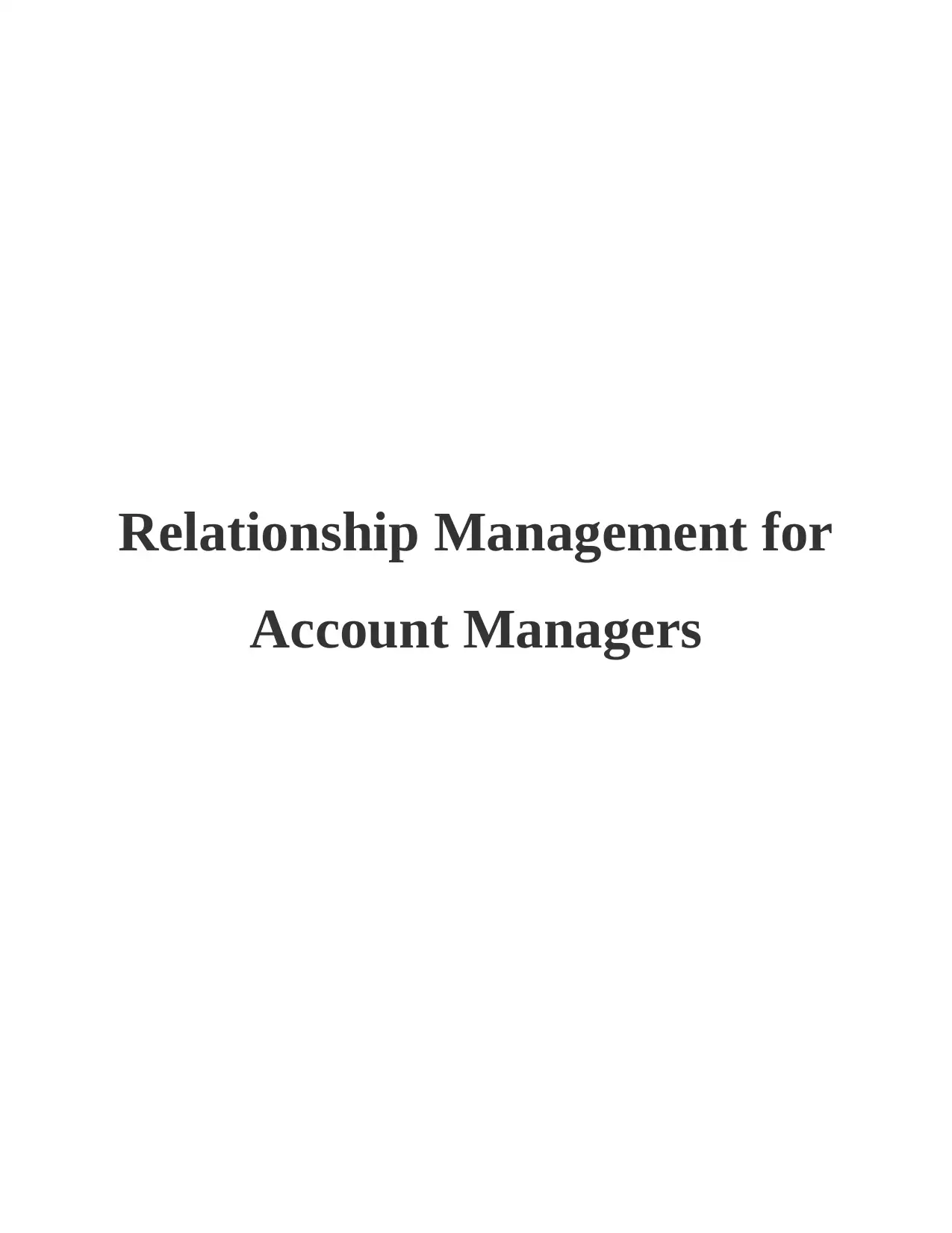
Relationship Management for
Account Managers
Account Managers
Paraphrase This Document
Need a fresh take? Get an instant paraphrase of this document with our AI Paraphraser
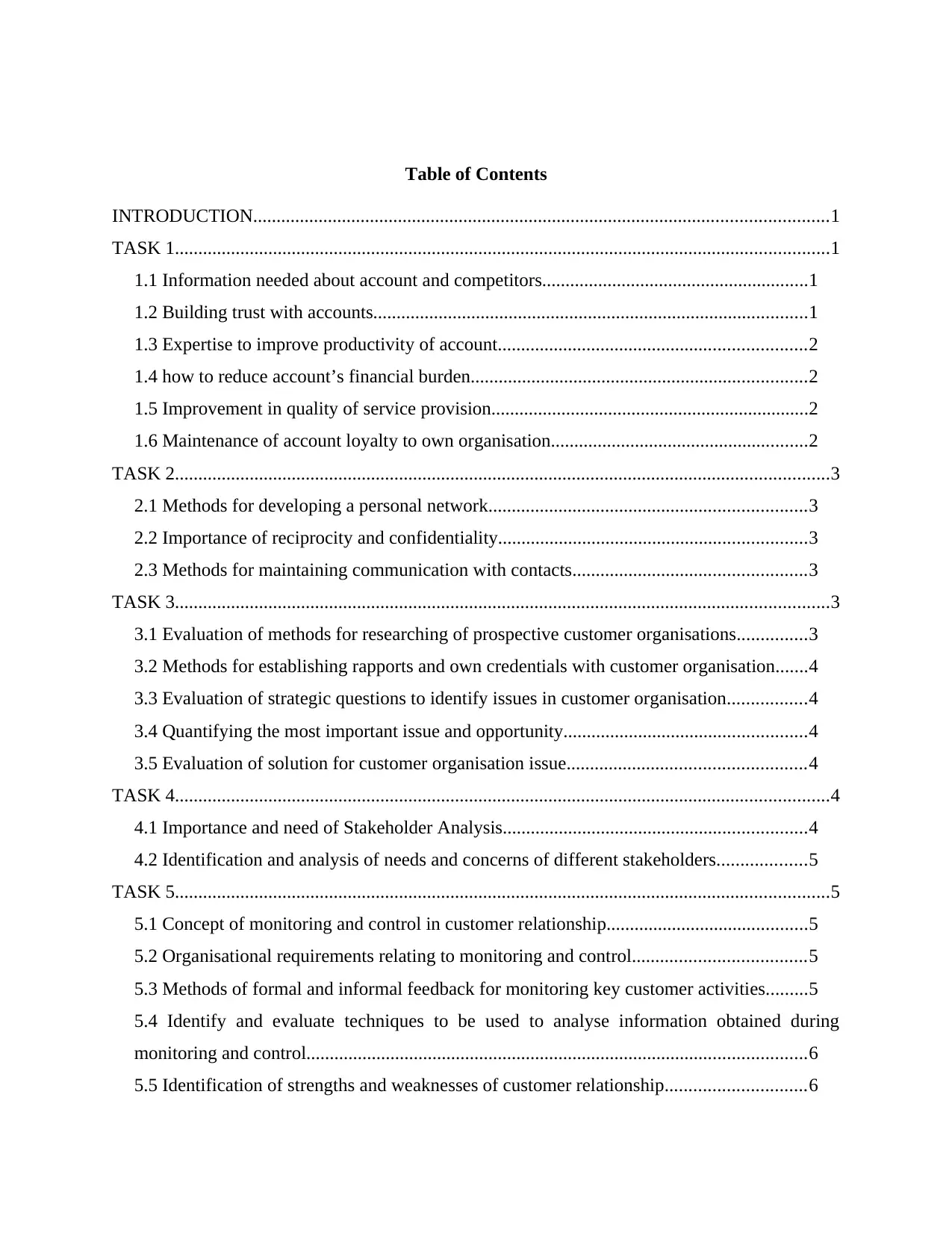
Table of Contents
INTRODUCTION...........................................................................................................................1
TASK 1............................................................................................................................................1
1.1 Information needed about account and competitors.........................................................1
1.2 Building trust with accounts.............................................................................................1
1.3 Expertise to improve productivity of account..................................................................2
1.4 how to reduce account’s financial burden........................................................................2
1.5 Improvement in quality of service provision....................................................................2
1.6 Maintenance of account loyalty to own organisation.......................................................2
TASK 2............................................................................................................................................3
2.1 Methods for developing a personal network....................................................................3
2.2 Importance of reciprocity and confidentiality..................................................................3
2.3 Methods for maintaining communication with contacts..................................................3
TASK 3............................................................................................................................................3
3.1 Evaluation of methods for researching of prospective customer organisations...............3
3.2 Methods for establishing rapports and own credentials with customer organisation.......4
3.3 Evaluation of strategic questions to identify issues in customer organisation.................4
3.4 Quantifying the most important issue and opportunity....................................................4
3.5 Evaluation of solution for customer organisation issue...................................................4
TASK 4............................................................................................................................................4
4.1 Importance and need of Stakeholder Analysis.................................................................4
4.2 Identification and analysis of needs and concerns of different stakeholders...................5
TASK 5............................................................................................................................................5
5.1 Concept of monitoring and control in customer relationship...........................................5
5.2 Organisational requirements relating to monitoring and control.....................................5
5.3 Methods of formal and informal feedback for monitoring key customer activities.........5
5.4 Identify and evaluate techniques to be used to analyse information obtained during
monitoring and control...........................................................................................................6
5.5 Identification of strengths and weaknesses of customer relationship..............................6
INTRODUCTION...........................................................................................................................1
TASK 1............................................................................................................................................1
1.1 Information needed about account and competitors.........................................................1
1.2 Building trust with accounts.............................................................................................1
1.3 Expertise to improve productivity of account..................................................................2
1.4 how to reduce account’s financial burden........................................................................2
1.5 Improvement in quality of service provision....................................................................2
1.6 Maintenance of account loyalty to own organisation.......................................................2
TASK 2............................................................................................................................................3
2.1 Methods for developing a personal network....................................................................3
2.2 Importance of reciprocity and confidentiality..................................................................3
2.3 Methods for maintaining communication with contacts..................................................3
TASK 3............................................................................................................................................3
3.1 Evaluation of methods for researching of prospective customer organisations...............3
3.2 Methods for establishing rapports and own credentials with customer organisation.......4
3.3 Evaluation of strategic questions to identify issues in customer organisation.................4
3.4 Quantifying the most important issue and opportunity....................................................4
3.5 Evaluation of solution for customer organisation issue...................................................4
TASK 4............................................................................................................................................4
4.1 Importance and need of Stakeholder Analysis.................................................................4
4.2 Identification and analysis of needs and concerns of different stakeholders...................5
TASK 5............................................................................................................................................5
5.1 Concept of monitoring and control in customer relationship...........................................5
5.2 Organisational requirements relating to monitoring and control.....................................5
5.3 Methods of formal and informal feedback for monitoring key customer activities.........5
5.4 Identify and evaluate techniques to be used to analyse information obtained during
monitoring and control...........................................................................................................6
5.5 Identification of strengths and weaknesses of customer relationship..............................6

CONCLUSION................................................................................................................................6
REFERENCES................................................................................................................................7
REFERENCES................................................................................................................................7
⊘ This is a preview!⊘
Do you want full access?
Subscribe today to unlock all pages.

Trusted by 1+ million students worldwide
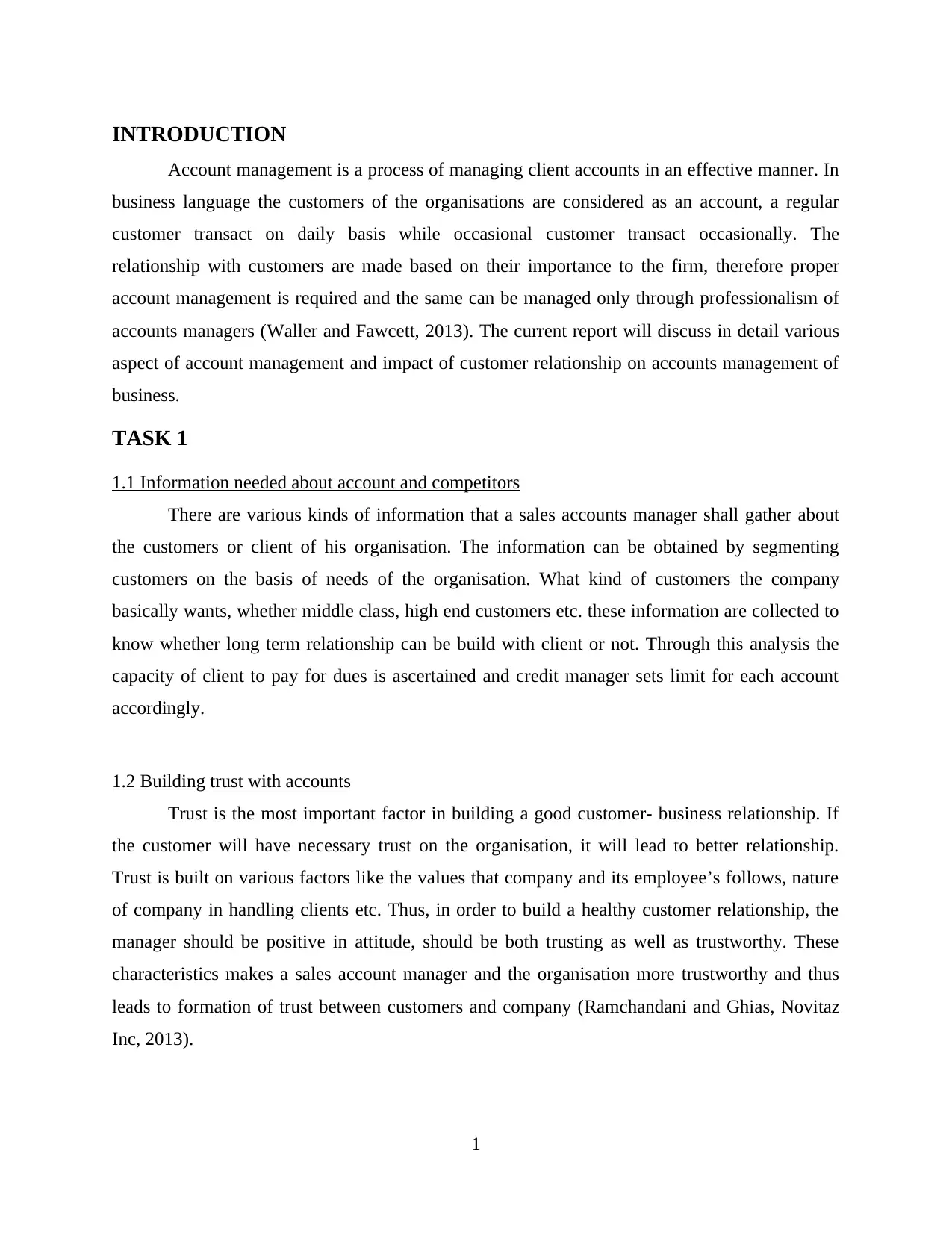
INTRODUCTION
Account management is a process of managing client accounts in an effective manner. In
business language the customers of the organisations are considered as an account, a regular
customer transact on daily basis while occasional customer transact occasionally. The
relationship with customers are made based on their importance to the firm, therefore proper
account management is required and the same can be managed only through professionalism of
accounts managers (Waller and Fawcett, 2013). The current report will discuss in detail various
aspect of account management and impact of customer relationship on accounts management of
business.
TASK 1
1.1 Information needed about account and competitors
There are various kinds of information that a sales accounts manager shall gather about
the customers or client of his organisation. The information can be obtained by segmenting
customers on the basis of needs of the organisation. What kind of customers the company
basically wants, whether middle class, high end customers etc. these information are collected to
know whether long term relationship can be build with client or not. Through this analysis the
capacity of client to pay for dues is ascertained and credit manager sets limit for each account
accordingly.
1.2 Building trust with accounts
Trust is the most important factor in building a good customer- business relationship. If
the customer will have necessary trust on the organisation, it will lead to better relationship.
Trust is built on various factors like the values that company and its employee’s follows, nature
of company in handling clients etc. Thus, in order to build a healthy customer relationship, the
manager should be positive in attitude, should be both trusting as well as trustworthy. These
characteristics makes a sales account manager and the organisation more trustworthy and thus
leads to formation of trust between customers and company (Ramchandani and Ghias, Novitaz
Inc, 2013).
1
Account management is a process of managing client accounts in an effective manner. In
business language the customers of the organisations are considered as an account, a regular
customer transact on daily basis while occasional customer transact occasionally. The
relationship with customers are made based on their importance to the firm, therefore proper
account management is required and the same can be managed only through professionalism of
accounts managers (Waller and Fawcett, 2013). The current report will discuss in detail various
aspect of account management and impact of customer relationship on accounts management of
business.
TASK 1
1.1 Information needed about account and competitors
There are various kinds of information that a sales accounts manager shall gather about
the customers or client of his organisation. The information can be obtained by segmenting
customers on the basis of needs of the organisation. What kind of customers the company
basically wants, whether middle class, high end customers etc. these information are collected to
know whether long term relationship can be build with client or not. Through this analysis the
capacity of client to pay for dues is ascertained and credit manager sets limit for each account
accordingly.
1.2 Building trust with accounts
Trust is the most important factor in building a good customer- business relationship. If
the customer will have necessary trust on the organisation, it will lead to better relationship.
Trust is built on various factors like the values that company and its employee’s follows, nature
of company in handling clients etc. Thus, in order to build a healthy customer relationship, the
manager should be positive in attitude, should be both trusting as well as trustworthy. These
characteristics makes a sales account manager and the organisation more trustworthy and thus
leads to formation of trust between customers and company (Ramchandani and Ghias, Novitaz
Inc, 2013).
1
Paraphrase This Document
Need a fresh take? Get an instant paraphrase of this document with our AI Paraphraser
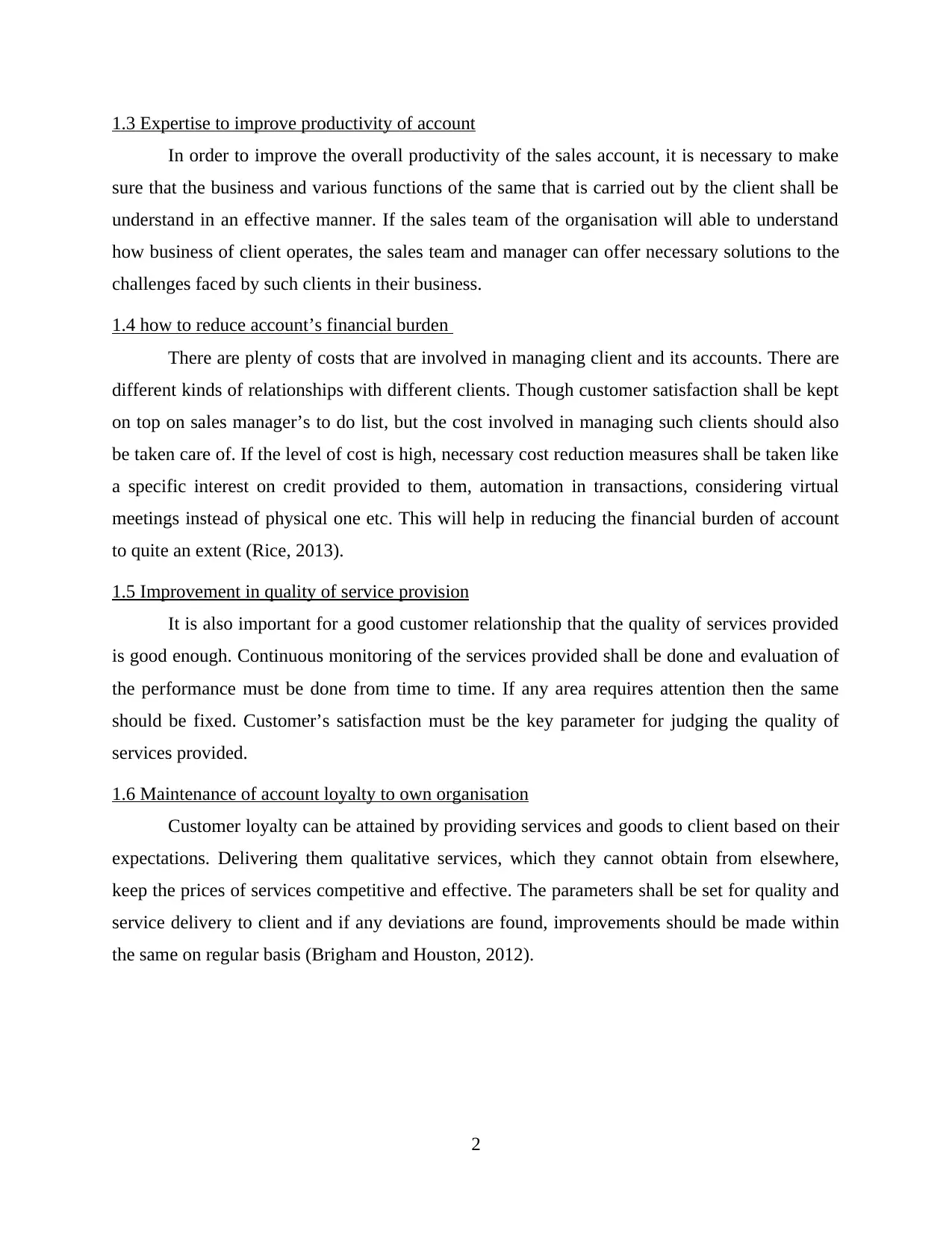
1.3 Expertise to improve productivity of account
In order to improve the overall productivity of the sales account, it is necessary to make
sure that the business and various functions of the same that is carried out by the client shall be
understand in an effective manner. If the sales team of the organisation will able to understand
how business of client operates, the sales team and manager can offer necessary solutions to the
challenges faced by such clients in their business.
1.4 how to reduce account’s financial burden
There are plenty of costs that are involved in managing client and its accounts. There are
different kinds of relationships with different clients. Though customer satisfaction shall be kept
on top on sales manager’s to do list, but the cost involved in managing such clients should also
be taken care of. If the level of cost is high, necessary cost reduction measures shall be taken like
a specific interest on credit provided to them, automation in transactions, considering virtual
meetings instead of physical one etc. This will help in reducing the financial burden of account
to quite an extent (Rice, 2013).
1.5 Improvement in quality of service provision
It is also important for a good customer relationship that the quality of services provided
is good enough. Continuous monitoring of the services provided shall be done and evaluation of
the performance must be done from time to time. If any area requires attention then the same
should be fixed. Customer’s satisfaction must be the key parameter for judging the quality of
services provided.
1.6 Maintenance of account loyalty to own organisation
Customer loyalty can be attained by providing services and goods to client based on their
expectations. Delivering them qualitative services, which they cannot obtain from elsewhere,
keep the prices of services competitive and effective. The parameters shall be set for quality and
service delivery to client and if any deviations are found, improvements should be made within
the same on regular basis (Brigham and Houston, 2012).
2
In order to improve the overall productivity of the sales account, it is necessary to make
sure that the business and various functions of the same that is carried out by the client shall be
understand in an effective manner. If the sales team of the organisation will able to understand
how business of client operates, the sales team and manager can offer necessary solutions to the
challenges faced by such clients in their business.
1.4 how to reduce account’s financial burden
There are plenty of costs that are involved in managing client and its accounts. There are
different kinds of relationships with different clients. Though customer satisfaction shall be kept
on top on sales manager’s to do list, but the cost involved in managing such clients should also
be taken care of. If the level of cost is high, necessary cost reduction measures shall be taken like
a specific interest on credit provided to them, automation in transactions, considering virtual
meetings instead of physical one etc. This will help in reducing the financial burden of account
to quite an extent (Rice, 2013).
1.5 Improvement in quality of service provision
It is also important for a good customer relationship that the quality of services provided
is good enough. Continuous monitoring of the services provided shall be done and evaluation of
the performance must be done from time to time. If any area requires attention then the same
should be fixed. Customer’s satisfaction must be the key parameter for judging the quality of
services provided.
1.6 Maintenance of account loyalty to own organisation
Customer loyalty can be attained by providing services and goods to client based on their
expectations. Delivering them qualitative services, which they cannot obtain from elsewhere,
keep the prices of services competitive and effective. The parameters shall be set for quality and
service delivery to client and if any deviations are found, improvements should be made within
the same on regular basis (Brigham and Houston, 2012).
2
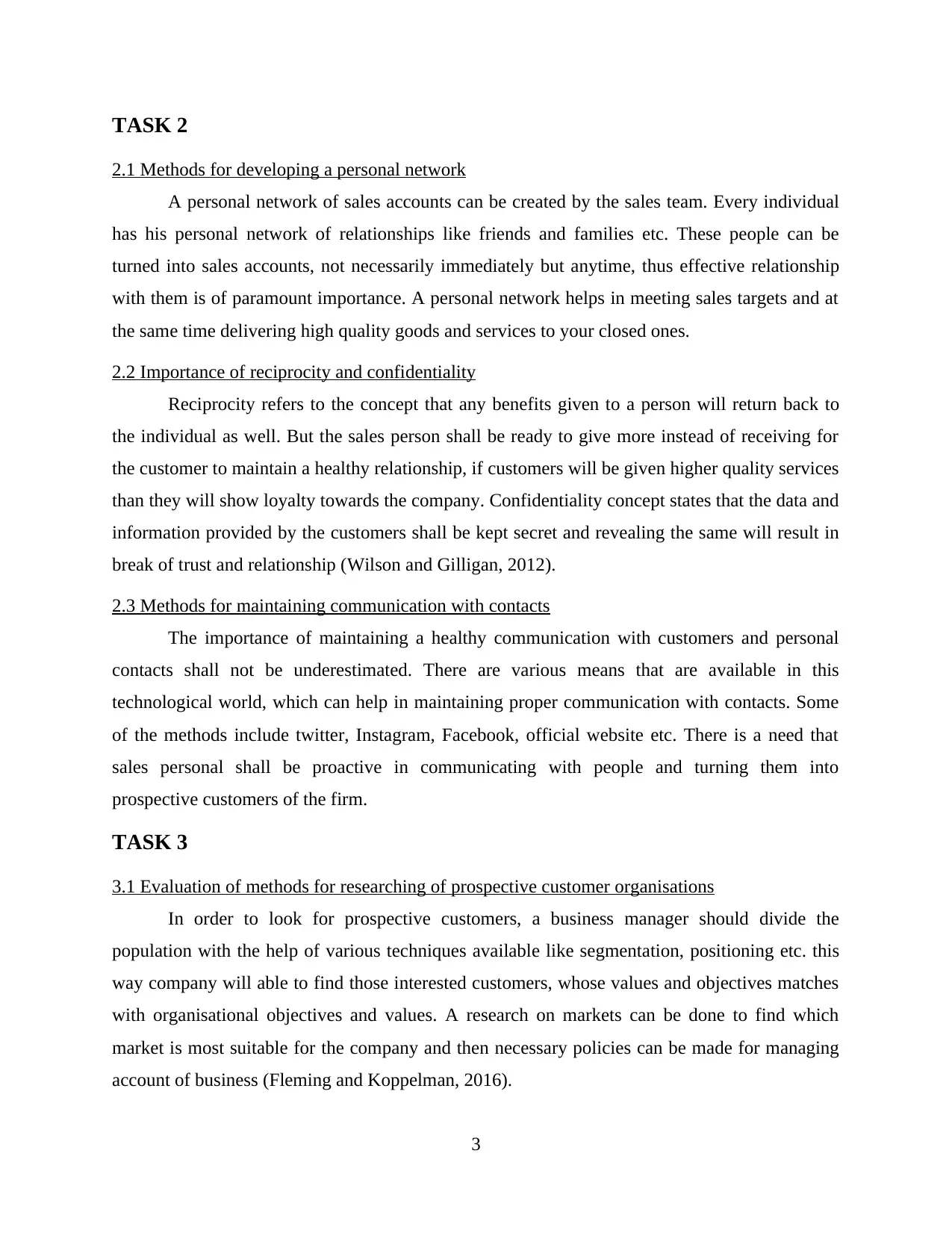
TASK 2
2.1 Methods for developing a personal network
A personal network of sales accounts can be created by the sales team. Every individual
has his personal network of relationships like friends and families etc. These people can be
turned into sales accounts, not necessarily immediately but anytime, thus effective relationship
with them is of paramount importance. A personal network helps in meeting sales targets and at
the same time delivering high quality goods and services to your closed ones.
2.2 Importance of reciprocity and confidentiality
Reciprocity refers to the concept that any benefits given to a person will return back to
the individual as well. But the sales person shall be ready to give more instead of receiving for
the customer to maintain a healthy relationship, if customers will be given higher quality services
than they will show loyalty towards the company. Confidentiality concept states that the data and
information provided by the customers shall be kept secret and revealing the same will result in
break of trust and relationship (Wilson and Gilligan, 2012).
2.3 Methods for maintaining communication with contacts
The importance of maintaining a healthy communication with customers and personal
contacts shall not be underestimated. There are various means that are available in this
technological world, which can help in maintaining proper communication with contacts. Some
of the methods include twitter, Instagram, Facebook, official website etc. There is a need that
sales personal shall be proactive in communicating with people and turning them into
prospective customers of the firm.
TASK 3
3.1 Evaluation of methods for researching of prospective customer organisations
In order to look for prospective customers, a business manager should divide the
population with the help of various techniques available like segmentation, positioning etc. this
way company will able to find those interested customers, whose values and objectives matches
with organisational objectives and values. A research on markets can be done to find which
market is most suitable for the company and then necessary policies can be made for managing
account of business (Fleming and Koppelman, 2016).
3
2.1 Methods for developing a personal network
A personal network of sales accounts can be created by the sales team. Every individual
has his personal network of relationships like friends and families etc. These people can be
turned into sales accounts, not necessarily immediately but anytime, thus effective relationship
with them is of paramount importance. A personal network helps in meeting sales targets and at
the same time delivering high quality goods and services to your closed ones.
2.2 Importance of reciprocity and confidentiality
Reciprocity refers to the concept that any benefits given to a person will return back to
the individual as well. But the sales person shall be ready to give more instead of receiving for
the customer to maintain a healthy relationship, if customers will be given higher quality services
than they will show loyalty towards the company. Confidentiality concept states that the data and
information provided by the customers shall be kept secret and revealing the same will result in
break of trust and relationship (Wilson and Gilligan, 2012).
2.3 Methods for maintaining communication with contacts
The importance of maintaining a healthy communication with customers and personal
contacts shall not be underestimated. There are various means that are available in this
technological world, which can help in maintaining proper communication with contacts. Some
of the methods include twitter, Instagram, Facebook, official website etc. There is a need that
sales personal shall be proactive in communicating with people and turning them into
prospective customers of the firm.
TASK 3
3.1 Evaluation of methods for researching of prospective customer organisations
In order to look for prospective customers, a business manager should divide the
population with the help of various techniques available like segmentation, positioning etc. this
way company will able to find those interested customers, whose values and objectives matches
with organisational objectives and values. A research on markets can be done to find which
market is most suitable for the company and then necessary policies can be made for managing
account of business (Fleming and Koppelman, 2016).
3
⊘ This is a preview!⊘
Do you want full access?
Subscribe today to unlock all pages.

Trusted by 1+ million students worldwide
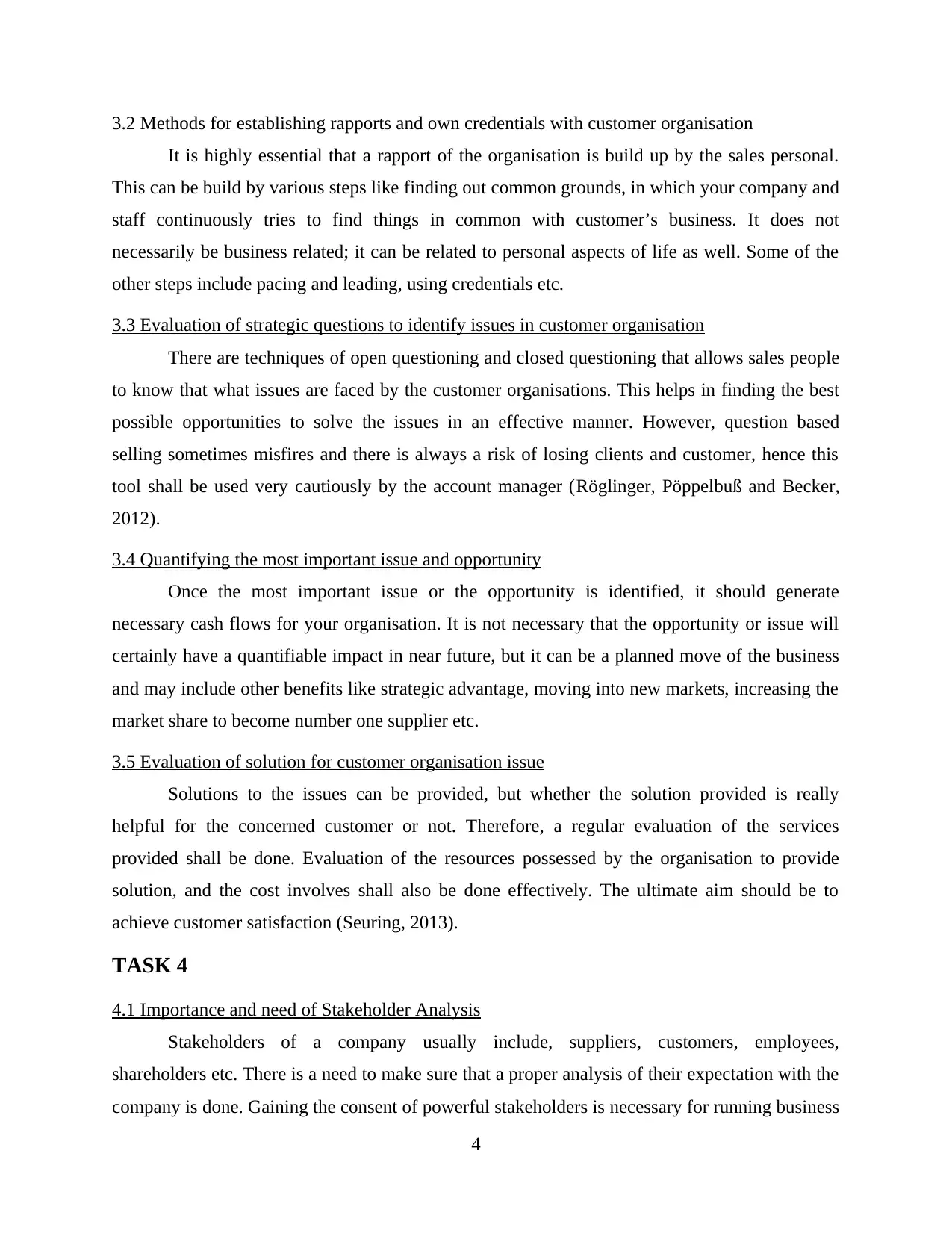
3.2 Methods for establishing rapports and own credentials with customer organisation
It is highly essential that a rapport of the organisation is build up by the sales personal.
This can be build by various steps like finding out common grounds, in which your company and
staff continuously tries to find things in common with customer’s business. It does not
necessarily be business related; it can be related to personal aspects of life as well. Some of the
other steps include pacing and leading, using credentials etc.
3.3 Evaluation of strategic questions to identify issues in customer organisation
There are techniques of open questioning and closed questioning that allows sales people
to know that what issues are faced by the customer organisations. This helps in finding the best
possible opportunities to solve the issues in an effective manner. However, question based
selling sometimes misfires and there is always a risk of losing clients and customer, hence this
tool shall be used very cautiously by the account manager (Röglinger, Pöppelbuß and Becker,
2012).
3.4 Quantifying the most important issue and opportunity
Once the most important issue or the opportunity is identified, it should generate
necessary cash flows for your organisation. It is not necessary that the opportunity or issue will
certainly have a quantifiable impact in near future, but it can be a planned move of the business
and may include other benefits like strategic advantage, moving into new markets, increasing the
market share to become number one supplier etc.
3.5 Evaluation of solution for customer organisation issue
Solutions to the issues can be provided, but whether the solution provided is really
helpful for the concerned customer or not. Therefore, a regular evaluation of the services
provided shall be done. Evaluation of the resources possessed by the organisation to provide
solution, and the cost involves shall also be done effectively. The ultimate aim should be to
achieve customer satisfaction (Seuring, 2013).
TASK 4
4.1 Importance and need of Stakeholder Analysis
Stakeholders of a company usually include, suppliers, customers, employees,
shareholders etc. There is a need to make sure that a proper analysis of their expectation with the
company is done. Gaining the consent of powerful stakeholders is necessary for running business
4
It is highly essential that a rapport of the organisation is build up by the sales personal.
This can be build by various steps like finding out common grounds, in which your company and
staff continuously tries to find things in common with customer’s business. It does not
necessarily be business related; it can be related to personal aspects of life as well. Some of the
other steps include pacing and leading, using credentials etc.
3.3 Evaluation of strategic questions to identify issues in customer organisation
There are techniques of open questioning and closed questioning that allows sales people
to know that what issues are faced by the customer organisations. This helps in finding the best
possible opportunities to solve the issues in an effective manner. However, question based
selling sometimes misfires and there is always a risk of losing clients and customer, hence this
tool shall be used very cautiously by the account manager (Röglinger, Pöppelbuß and Becker,
2012).
3.4 Quantifying the most important issue and opportunity
Once the most important issue or the opportunity is identified, it should generate
necessary cash flows for your organisation. It is not necessary that the opportunity or issue will
certainly have a quantifiable impact in near future, but it can be a planned move of the business
and may include other benefits like strategic advantage, moving into new markets, increasing the
market share to become number one supplier etc.
3.5 Evaluation of solution for customer organisation issue
Solutions to the issues can be provided, but whether the solution provided is really
helpful for the concerned customer or not. Therefore, a regular evaluation of the services
provided shall be done. Evaluation of the resources possessed by the organisation to provide
solution, and the cost involves shall also be done effectively. The ultimate aim should be to
achieve customer satisfaction (Seuring, 2013).
TASK 4
4.1 Importance and need of Stakeholder Analysis
Stakeholders of a company usually include, suppliers, customers, employees,
shareholders etc. There is a need to make sure that a proper analysis of their expectation with the
company is done. Gaining the consent of powerful stakeholders is necessary for running business
4
Paraphrase This Document
Need a fresh take? Get an instant paraphrase of this document with our AI Paraphraser
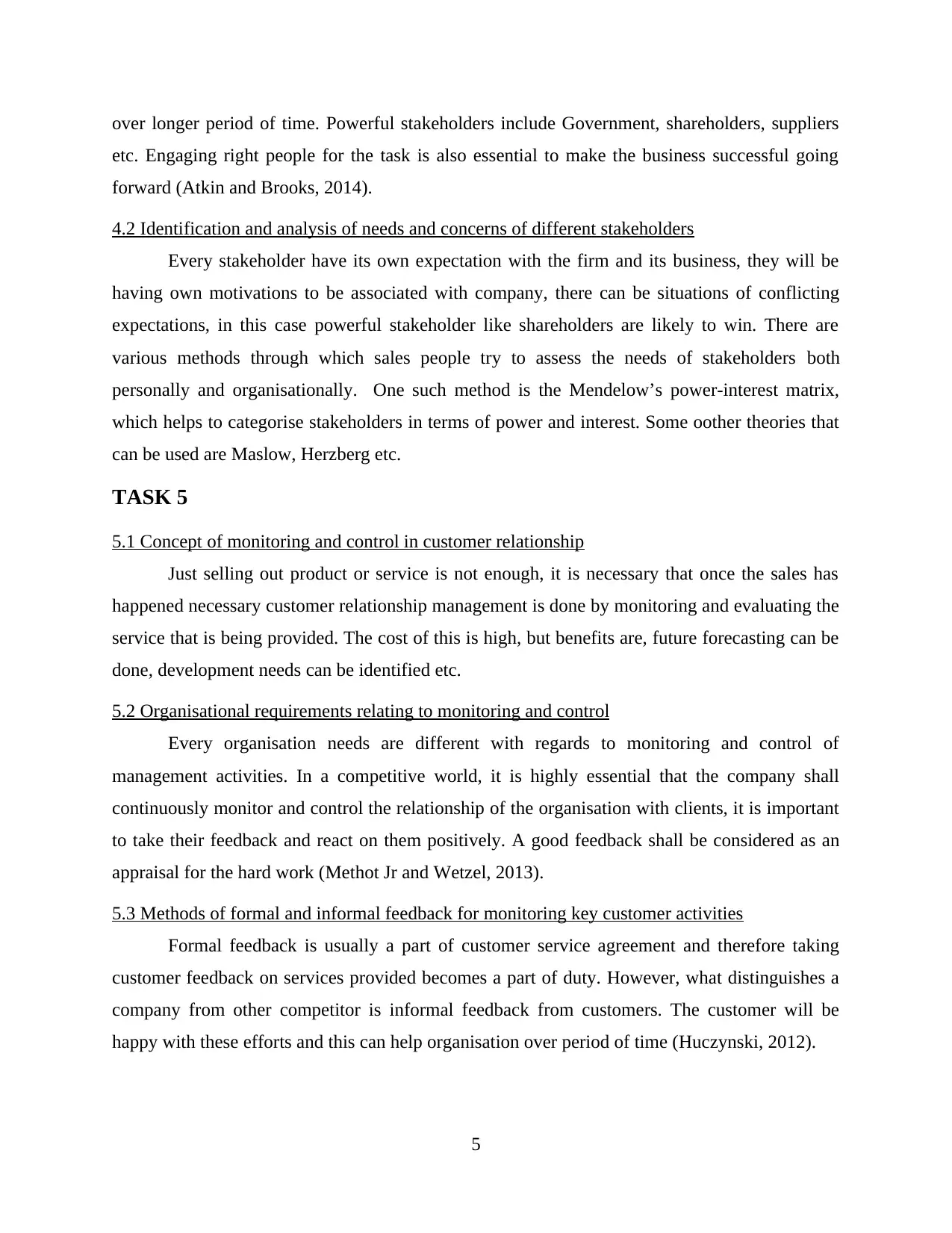
over longer period of time. Powerful stakeholders include Government, shareholders, suppliers
etc. Engaging right people for the task is also essential to make the business successful going
forward (Atkin and Brooks, 2014).
4.2 Identification and analysis of needs and concerns of different stakeholders
Every stakeholder have its own expectation with the firm and its business, they will be
having own motivations to be associated with company, there can be situations of conflicting
expectations, in this case powerful stakeholder like shareholders are likely to win. There are
various methods through which sales people try to assess the needs of stakeholders both
personally and organisationally. One such method is the Mendelow’s power-interest matrix,
which helps to categorise stakeholders in terms of power and interest. Some oother theories that
can be used are Maslow, Herzberg etc.
TASK 5
5.1 Concept of monitoring and control in customer relationship
Just selling out product or service is not enough, it is necessary that once the sales has
happened necessary customer relationship management is done by monitoring and evaluating the
service that is being provided. The cost of this is high, but benefits are, future forecasting can be
done, development needs can be identified etc.
5.2 Organisational requirements relating to monitoring and control
Every organisation needs are different with regards to monitoring and control of
management activities. In a competitive world, it is highly essential that the company shall
continuously monitor and control the relationship of the organisation with clients, it is important
to take their feedback and react on them positively. A good feedback shall be considered as an
appraisal for the hard work (Methot Jr and Wetzel, 2013).
5.3 Methods of formal and informal feedback for monitoring key customer activities
Formal feedback is usually a part of customer service agreement and therefore taking
customer feedback on services provided becomes a part of duty. However, what distinguishes a
company from other competitor is informal feedback from customers. The customer will be
happy with these efforts and this can help organisation over period of time (Huczynski, 2012).
5
etc. Engaging right people for the task is also essential to make the business successful going
forward (Atkin and Brooks, 2014).
4.2 Identification and analysis of needs and concerns of different stakeholders
Every stakeholder have its own expectation with the firm and its business, they will be
having own motivations to be associated with company, there can be situations of conflicting
expectations, in this case powerful stakeholder like shareholders are likely to win. There are
various methods through which sales people try to assess the needs of stakeholders both
personally and organisationally. One such method is the Mendelow’s power-interest matrix,
which helps to categorise stakeholders in terms of power and interest. Some oother theories that
can be used are Maslow, Herzberg etc.
TASK 5
5.1 Concept of monitoring and control in customer relationship
Just selling out product or service is not enough, it is necessary that once the sales has
happened necessary customer relationship management is done by monitoring and evaluating the
service that is being provided. The cost of this is high, but benefits are, future forecasting can be
done, development needs can be identified etc.
5.2 Organisational requirements relating to monitoring and control
Every organisation needs are different with regards to monitoring and control of
management activities. In a competitive world, it is highly essential that the company shall
continuously monitor and control the relationship of the organisation with clients, it is important
to take their feedback and react on them positively. A good feedback shall be considered as an
appraisal for the hard work (Methot Jr and Wetzel, 2013).
5.3 Methods of formal and informal feedback for monitoring key customer activities
Formal feedback is usually a part of customer service agreement and therefore taking
customer feedback on services provided becomes a part of duty. However, what distinguishes a
company from other competitor is informal feedback from customers. The customer will be
happy with these efforts and this can help organisation over period of time (Huczynski, 2012).
5
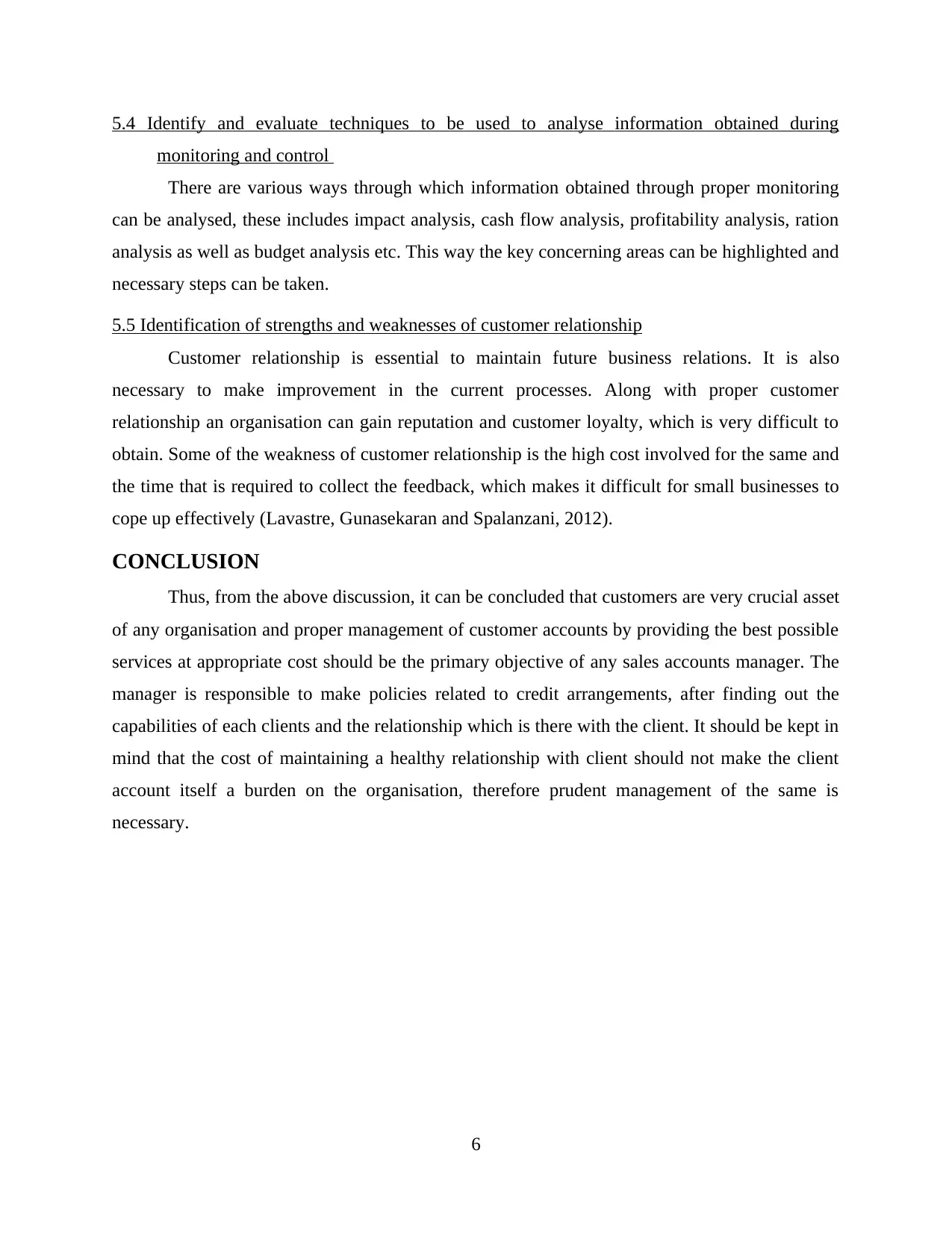
5.4 Identify and evaluate techniques to be used to analyse information obtained during
monitoring and control
There are various ways through which information obtained through proper monitoring
can be analysed, these includes impact analysis, cash flow analysis, profitability analysis, ration
analysis as well as budget analysis etc. This way the key concerning areas can be highlighted and
necessary steps can be taken.
5.5 Identification of strengths and weaknesses of customer relationship
Customer relationship is essential to maintain future business relations. It is also
necessary to make improvement in the current processes. Along with proper customer
relationship an organisation can gain reputation and customer loyalty, which is very difficult to
obtain. Some of the weakness of customer relationship is the high cost involved for the same and
the time that is required to collect the feedback, which makes it difficult for small businesses to
cope up effectively (Lavastre, Gunasekaran and Spalanzani, 2012).
CONCLUSION
Thus, from the above discussion, it can be concluded that customers are very crucial asset
of any organisation and proper management of customer accounts by providing the best possible
services at appropriate cost should be the primary objective of any sales accounts manager. The
manager is responsible to make policies related to credit arrangements, after finding out the
capabilities of each clients and the relationship which is there with the client. It should be kept in
mind that the cost of maintaining a healthy relationship with client should not make the client
account itself a burden on the organisation, therefore prudent management of the same is
necessary.
6
monitoring and control
There are various ways through which information obtained through proper monitoring
can be analysed, these includes impact analysis, cash flow analysis, profitability analysis, ration
analysis as well as budget analysis etc. This way the key concerning areas can be highlighted and
necessary steps can be taken.
5.5 Identification of strengths and weaknesses of customer relationship
Customer relationship is essential to maintain future business relations. It is also
necessary to make improvement in the current processes. Along with proper customer
relationship an organisation can gain reputation and customer loyalty, which is very difficult to
obtain. Some of the weakness of customer relationship is the high cost involved for the same and
the time that is required to collect the feedback, which makes it difficult for small businesses to
cope up effectively (Lavastre, Gunasekaran and Spalanzani, 2012).
CONCLUSION
Thus, from the above discussion, it can be concluded that customers are very crucial asset
of any organisation and proper management of customer accounts by providing the best possible
services at appropriate cost should be the primary objective of any sales accounts manager. The
manager is responsible to make policies related to credit arrangements, after finding out the
capabilities of each clients and the relationship which is there with the client. It should be kept in
mind that the cost of maintaining a healthy relationship with client should not make the client
account itself a burden on the organisation, therefore prudent management of the same is
necessary.
6
⊘ This is a preview!⊘
Do you want full access?
Subscribe today to unlock all pages.

Trusted by 1+ million students worldwide

REFERENCES
Books and Journals
Atef, F. and Dabirian, A., 2012. System and method for identity verification and management.
U.S. Patent 8,224,753.
Atkin, B. and Brooks, A., 2014. Total facility management. John Wiley & Sons.
Brigham, E.F. and Houston, J.F., 2012. Fundamentals of financial management. Cengage
Learning.
Christ, K.L. and Burritt, R.L., 2013. Environmental management accounting: the significance of
contingent variables for adoption. Journal of Cleaner Production. 41. pp.163-173.
Fleming, Q.W. and Koppelman, J.M., 2016, December. Earned value project management.
Project Management Institute.
Hill, T., 2017. Manufacturing strategy: the strategic management of the manufacturing function.
Macmillan International Higher Education.
Huczynski, A., 2012. Management gurus. Routledge.
Hugos, M.H., 2018. Essentials of supply chain management. John Wiley & Sons.
Lavastre, O., Gunasekaran, A. and Spalanzani, A., 2012. Supply chain risk management in
French companies. Decision Support Systems. 52(4). pp.828-838.
Methot Jr, R.D. and Wetzel, C.R., 2013. Stock synthesis: a biological and statistical framework
for fish stock assessment and fishery management. Fisheries Research. 142. pp.86-99.
Ramchandani, J. and Ghias, A., Novitaz Inc, 2013. Customer relationship management system
for physical locations. U.S. Patent 8,600,804.
Rice, A.K., 2013. Productivity and social organization: The Ahmedabad experiment: Technical
innovation, work organization and management. Routledge.
Röglinger, M., Pöppelbuß, J. and Becker, J., 2012. Maturity models in business process
management. Business process management journal. 18(2). pp.328-346.
Seuring, S., 2013. A review of modeling approaches for sustainable supply chain management.
Decision support systems. 54(4). pp.1513-1520.
Vaiman, V., Scullion, H. and Collings, D., 2012. Talent management decision making.
Management Decision. 50(5). pp.925-941.
Von Krogh, G., 2012. How does social software change knowledge management? Toward a
strategic research agenda. The Journal of Strategic Information systems. 21(2). pp.154-
164.
Waller, M.A. and Fawcett, S.E., 2013. Data science, predictive analytics, and big data: a
revolution that will transform supply chain design and management. Journal of Business
Logistics. 34(2). pp.77-84.
Wilson, R.M. and Gilligan, C., 2012. Strategic marketing management. Routledge.
Wisner, J.D., Tan, K.C. and Leong, G.K., 2014. Principles of supply chain management: A
balanced approach. Cengage Learning.
7
Books and Journals
Atef, F. and Dabirian, A., 2012. System and method for identity verification and management.
U.S. Patent 8,224,753.
Atkin, B. and Brooks, A., 2014. Total facility management. John Wiley & Sons.
Brigham, E.F. and Houston, J.F., 2012. Fundamentals of financial management. Cengage
Learning.
Christ, K.L. and Burritt, R.L., 2013. Environmental management accounting: the significance of
contingent variables for adoption. Journal of Cleaner Production. 41. pp.163-173.
Fleming, Q.W. and Koppelman, J.M., 2016, December. Earned value project management.
Project Management Institute.
Hill, T., 2017. Manufacturing strategy: the strategic management of the manufacturing function.
Macmillan International Higher Education.
Huczynski, A., 2012. Management gurus. Routledge.
Hugos, M.H., 2018. Essentials of supply chain management. John Wiley & Sons.
Lavastre, O., Gunasekaran, A. and Spalanzani, A., 2012. Supply chain risk management in
French companies. Decision Support Systems. 52(4). pp.828-838.
Methot Jr, R.D. and Wetzel, C.R., 2013. Stock synthesis: a biological and statistical framework
for fish stock assessment and fishery management. Fisheries Research. 142. pp.86-99.
Ramchandani, J. and Ghias, A., Novitaz Inc, 2013. Customer relationship management system
for physical locations. U.S. Patent 8,600,804.
Rice, A.K., 2013. Productivity and social organization: The Ahmedabad experiment: Technical
innovation, work organization and management. Routledge.
Röglinger, M., Pöppelbuß, J. and Becker, J., 2012. Maturity models in business process
management. Business process management journal. 18(2). pp.328-346.
Seuring, S., 2013. A review of modeling approaches for sustainable supply chain management.
Decision support systems. 54(4). pp.1513-1520.
Vaiman, V., Scullion, H. and Collings, D., 2012. Talent management decision making.
Management Decision. 50(5). pp.925-941.
Von Krogh, G., 2012. How does social software change knowledge management? Toward a
strategic research agenda. The Journal of Strategic Information systems. 21(2). pp.154-
164.
Waller, M.A. and Fawcett, S.E., 2013. Data science, predictive analytics, and big data: a
revolution that will transform supply chain design and management. Journal of Business
Logistics. 34(2). pp.77-84.
Wilson, R.M. and Gilligan, C., 2012. Strategic marketing management. Routledge.
Wisner, J.D., Tan, K.C. and Leong, G.K., 2014. Principles of supply chain management: A
balanced approach. Cengage Learning.
7
Paraphrase This Document
Need a fresh take? Get an instant paraphrase of this document with our AI Paraphraser

8
1 out of 11
Related Documents
Your All-in-One AI-Powered Toolkit for Academic Success.
+13062052269
info@desklib.com
Available 24*7 on WhatsApp / Email
![[object Object]](/_next/static/media/star-bottom.7253800d.svg)
Unlock your academic potential
Copyright © 2020–2025 A2Z Services. All Rights Reserved. Developed and managed by ZUCOL.





